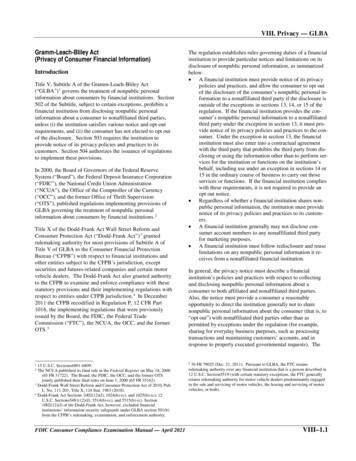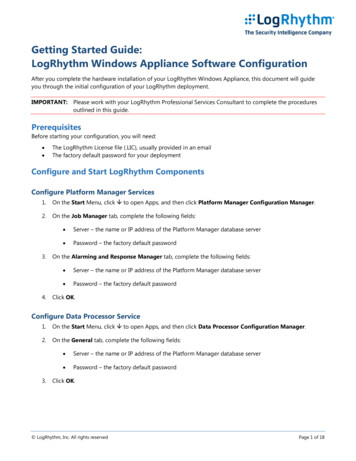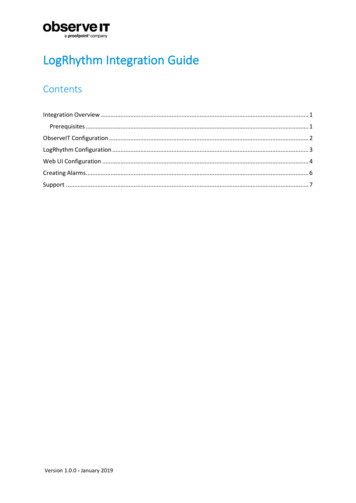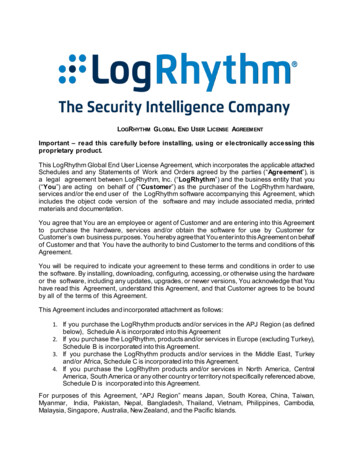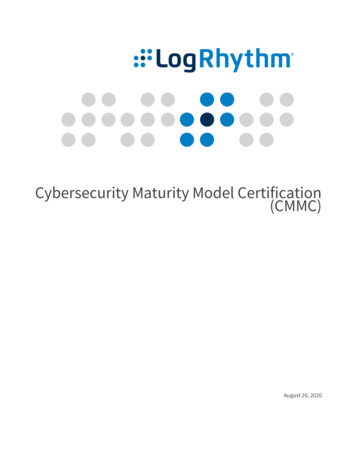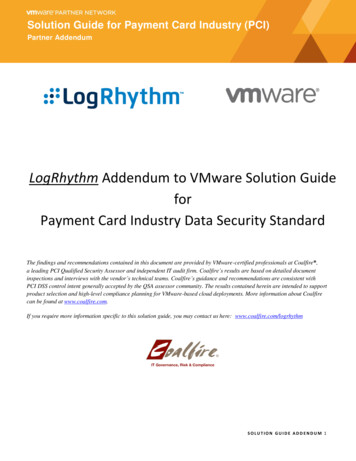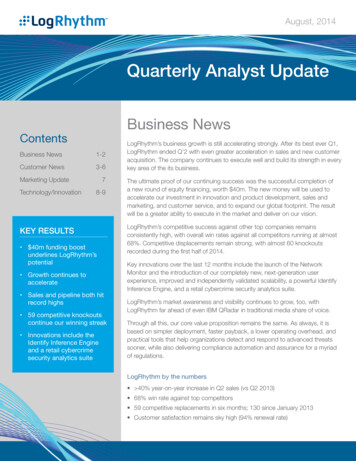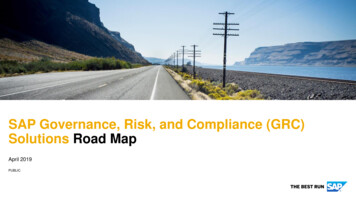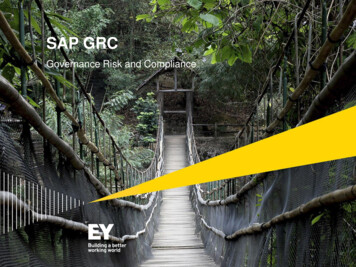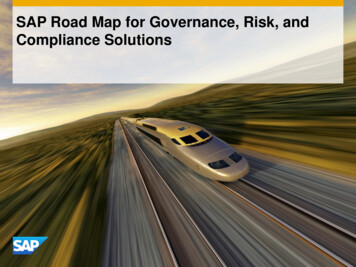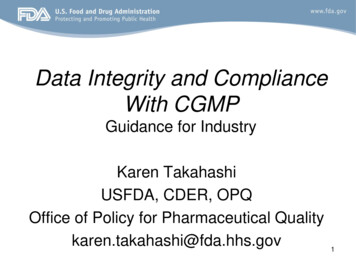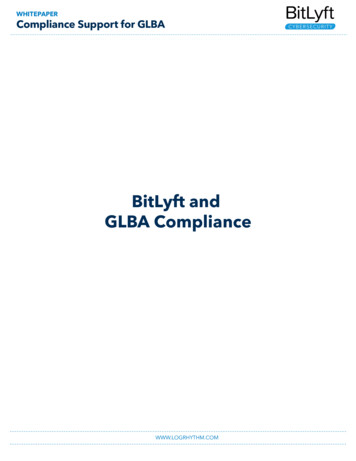
Transcription
WHITEPAPERCompliance Support for GLBABitLyft andGLBA ComplianceWWW.LOGRHYTHM.COM
WHITEPAPER - COMPLIANCE SUPPORT FOR GLBABitLyft and GLBA ComplianceThe Gramm-Leach-Bliley Act (GLBA), also known as TheFinancial Modernization Act of 1999, was enacted to ensureprotection over customer’s records and information.Authorization to implement this act was given to TheFederal Trade Commission (FTC) with an effective date forcompliance set on May 23, 2003. GLBA consists of threeprimary parts; the Financial Privacy Rule, Safeguards Rule,and Pretexting provisions. These rules and provisions makeup the requirements for financial institutions to (a) ensureprotection of the security and confidentiality of customer’snonpublic personal information (NPI), (b) implementadministrative, technical, and physical safeguards, (c) protectagainst anticipated threats and hazards to informationsecurity, and (d) protect against unauthorized access to or useof information. These requirements extend to an institutionsbusiness partners as well. Noncompliance can result inpenalties that include criminal prosecution, monetary finesand up to 5 years in prison.To satisfy these legal requirements, financial institutions arerequired to perform security risk assessments, develop andimplement security solutions that effectively detect, prevent,and allow timely incident response, and to performauditing and monitoring of their security environment.Section 501(b) of the GLBA established the highlevel privacy and security requirements that financialinstitutions must comply with in order to protectcustomer information.The collection, management, and analysis of log data isintegral to meeting many GLBA requirements. The use ofLogRhythm directly meets some requirements and decreasesthe cost of complying with others. IT environments consist ofheterogeneous devices, systems, and applications all reportinglog data. Millions of individual log entries can be generateddaily if not hourly. The task of organizing this informationcan be overwhelming in itself. The additional requirements ofanalyzing and reporting on log data prove manual processesor homegrown solutions inadequate and costly.LogRhythm can help. Log collection, archive, and recovery isfully automated across the entire IT infrastructure. LogRhythmautomatically performs the first level of log analysis. Log datais categorized, identified, and normalized for easy analysisand reporting. LogRhythm’s powerful alerting capabilityautomatically identifies the most critical issues and notifiesrelevant personnel. With the click of a mouse, LogRhythm’spre-configured GLBA report package ensures you meet yourreporting requirements.LogRhythm Report Center ScreenshotWWW.LOGRHYTHM.COMPAGE 1
WHITEPAPER - COMPLIANCE SUPPORT FOR GLBAGLBA requires financial institutions to implement and perform procedures to identify risks, eliminate or reduce these risks, andto monitor and maintain the implemented processes and procedures to ensure that the identified risks are effectively managed.The Federal Financial Institutions Examination Council (FFIEC), having been tasked with providing guidance and enforcement, hasdocumented the necessary controls for compliance in their “FFIEC Information Security Handbook”. The remainder of this paperlists the specific control requirements taken from both the FFIEC Information Security Handbook and associated Tier I and Tier IIExamination Procedures. For each control requirement, an explanation of how LogRhythm supports compliance is provided.Tier 1Objective 6. Determine the Adequacy of Security MonitoryLogRhythm can collect all relevant log messages that have an impact on security and monitoring responsibilities and alert on violations.Compliance Requirements1.6.1How LogRhythm Supports ComplianceObtain an understanding of the institution’s monitoringplans and activities, including both activity monitoringand condition monitoring.*Activity monitoring consists of host and network datagathering, and analysis.1.6.2Identify the organizational unit and personnelresponsible for performing the functions of a securityresponse center.LogRhythm provides central monitoring of activity and conditions by collecting logdata from hosts, applications, network devices, etc. LogRhythm provides real-timeevent monitoring, alerting, and reporting on specific activity and conditions.Example Reports: System Critical Conditions & Errors Account Management Activity System Startup & Shutdown SummaryLogRhythm’s integrated incident management capabilities support and automate manyfunctions of a security response center. Incidents (alarms) are tracked by status withinLogRhythm (i.e., new, open, closed). Activity around the alarm (e.g., notifications,analysis) is recorded in the alarm record. LogRhythm’s real-time dashboard providesa heads-up display of incident activity and associated response. LogRhythm reportsprovide comprehensive reporting on incident activity.1.6.4 Obtain and evaluate the policies governing securityresponse center functions, including monitoring,classification, escalation, and reporting.Example Reports: Security Event Summary Alarm & Response ActivityObjective 7. Evaluate the effectiveness of enterprise-wide security administrationLogRhythm collects and correlates all log data allowing Security Administrators to identify monitor activity and be alerted to specific conditions.Compliance RequirementsHow LogRhythm Supports Compliance1.7.2Determine whether management and department headsare adequately trained and sufficiently accountable forthe security of their personnel, information, and systems.LogRhythm’s security event management capabilities provide any organization acritical tool in monitoring and responding to the security of information & systems.Having a solution that provides real-time security event monitoring, alerting, andreporting is evidence of management level security diligence and enables auditaccountability across the enterprise.1.7.7Evaluate the adequacy of automated tools to supportsecure configuration management, security monitoring,policy monitoring, enforcement, and reporting.LogRhythm provides a proven, enterprise class solution for security monitoring.LogRhythm’s ability to collect all log data enables reporting on configuration &policy changes. LogRhythm’s incident management provides the tracking of applicable enforcement activities.Example Reports: Host Change Summary File Integrity Monitoring Activity Security Event Summary Alarm & Response ActivityWWW.LOGRHYTHM.COMPAGE 2
WHITEPAPER - COMPLIANCE SUPPORT FOR GLBATier 2A. Access Rights AdministrationLogRhythm collects all access right administration activity for monitoring, reporting, and alerting.Compliance Requirements2.A.4How LogRhythm Supports ComplianceDetermine that administrator or root privilege access isappropriately monitored, where appropriate.Management may choose to further categorize types ofadministrator/root access based upon a risk assessment.Categorizing this type of access can be used to identifyand monitor higher-risk administrator and root accessrequests that should be promptly reported.LogRhythm collects all account management and account usage activity. The creationof privileged accounts (i.e., administrator, root) or granting of privileged rights iseasily and automatically monitored, alerted, and reported on.Example Reports: Account Management Activity Host Access Granted & Revoked User Authentication Summary User Object Access SummaryA. AuthenticationLogRhythm can alert or report on all activity performed by privileged or sensitive User Accounts.Compliance Requirements2.A.2How LogRhythm Supports ComplianceDetermine whether access to system administrator levelis adequately controlled and monitored.LogRhythm collects all account management usage activity. The creation ofprivileged accounts (i.e., administrator, root) or granting of privileged rights is easilyand automatically monitored, alerted, and reported on.Example Reports: New Account Summary Host Access Granted & Revoked User Object Access SummaryB. Network SecurityLogRhythm collects logs from network infrastructure and security devices and provides real-time monitoring, alerting, and forensic analysis.Compliance Requirements2.B.12How LogRhythm Supports ComplianceDetermine whether logs of security-related events andlog analysis activities are sufficient to affix accountabilityfor network activities, as well as support intrusionforensics and IDS. Additionally, determine that adequateclock synchronization takes place.LogRhythm can collect logs from network devices, IDS/IPS systems, A/V systems,firewalls, and other security devices. LogRhythm provides central analysis andmonitoring of intrusion related activity across the IT infrastructure. LogRhythmcan correlate activity across user, origin host, impacted host, application andmore. LogRhythm can be configured to identify known bad hosts and networks.LogRhythm’s Personal Dashboard provides customized real-time monitoring of eventsand alerts. LogRhythm’s Investigator provides deep forensic analysis of intrusionrelated activity. LogRhythm’s integrated knowledge base provides information andreferences useful in responding to and resolving intrusions.LogRhythm automatically and independently synchronizes audit log time stamps toan absolute time standard (GMT). This ensures the true time of occurrence.WWW.LOGRHYTHM.COMPAGE 3
WHITEPAPER - COMPLIANCE SUPPORT FOR GLBACompliance Requirements2.B.132.B.17How LogRhythm Supports ComplianceDetermine whether logs of security-related events areappropriately secured against unauthorized access,change, and deletion for an adequate time period, andthat reporting to those logs is adequately protected.Determine whether logs of security-related events areappropriately secured against unauthorized access,change, and deletion for an adequate time period, andthat reporting to those logs is adequately protected.LogRhythm helps ensure audit trail are protected from unauthorized modification.LogRhythm collects logs immediately after they are generated and stores them in asecure repository. LogRhythm servers utilize access controls at the operating systemand application level to ensure that log data cannot be modified or deleted.Determine whether remote access devices and networkaccess points for remote equipment are appropriatelycontrolled. Remote access is disabled by default, and enabled onlyby management authorization. Management authorization is required for each userwho accesses sensitive components or data remotely. Authentication is of appropriate strength (e.g., twofactor for sensitive components). Modems are authorized, configured, and managed toappropriately mitigate risks. Appropriate logging and monitoring takes place. Remote access devices are appropriately secured andcontrolled by the institution.LogRhythm collect s network device logs. LogRhythm’s analysis & reportingcapabilities can used for reviewing network activity to ensure only authorizedcommunications occur. LogRhythm alerts can be used for detecting unauthorizedcommunications.LogRhythm completely automates the process of retaining your audit trail.LogRhythm creates archive files of all collected log entries. These files are organizedin a directory structure by day making it easy to store, backup, and destroy logarchives based on your policy.LogRhythm collects remote access activity for VPN, SSH, telnet, etc. LogRhythmreports provide easy and independent review of remote access to informationsystems.Example Reports: Network Service Summary Network Connection Summary Host Remote Access SummaryC. Host SecurityLogRhythm collects logs from hosts, and applications running on hosts, to provide real-time monitoring, alerting, and forensic analysis.Compliance Requirements2.C.7How LogRhythm Supports ComplianceDetermine whether access to utilities on the host areappropriately restricted and monitored.LogRhythm can collect audit logs reporting on the access and use of utilities on hostsfor monitoring and reporting. Additionally, LogRhythm’s file integrity monitoringcapability can be used to independently detect access and use of utilities.Example Reports: Host Access Granted & Revoked User Object Access Summary2.C.8Determine whether the host-based IDSs identified asnecessary in the risk assessment are properly installedand configured, that alerts go to appropriate individualsusing an out-of-band communications mechanism, andthat alerts are followed up.LogRhythm can collect logs from IDS/IPS systems. LogRhythm provides robustalerting and notification capabilities that help ensure alerts are routed to theappropriate individuals. LogRhythm’s integrated incident management capabilitiesprovide accountability and reporting on alarm resolution.2.C.9Determine whether logs are sufficient to affixaccountability for host activities and to support intrusionforensics and IDS and are appropriately secured for asufficient time period.LogRhythm helps ensure audit trail are protected from unauthorized modification.LogRhythm collects logs immediately after they are generated and stores them in asecure repository. LogRhythm servers utilize access controls at the operating systemand application level to ensure that log data cannot be modified or deleted.WWW.LOGRHYTHM.COMPAGE 4
WHITEPAPER - COMPLIANCE SUPPORT FOR GLBAG. Application SecurityLogRhythm can be configured to have log data readily available or securely archived for later restoration.Compliance Requirements2.G.8How LogRhythm Supports ComplianceDetermine whether appropriate logs are maintained andavailable to support incident detection and responseefforts.LogRhythm completely automates the process of retaining your audit trail.LogRhythm creates archive files of all collected log entries. These files are organizedin a directory structure by day making it easy to store, backup, and destroy logarchives based on your policy.H. Software Development and Acqu
LogRhythm can collect all relevant log messages that have an impact on security and monitoring responsibilities and alert on violations. Compliance Requirements How LogRhythm Supports Compliance 1.6.1 Obtain an understanding of the institution’s monitoring plans and activities, including both activity monitoring and condition monitoring.
